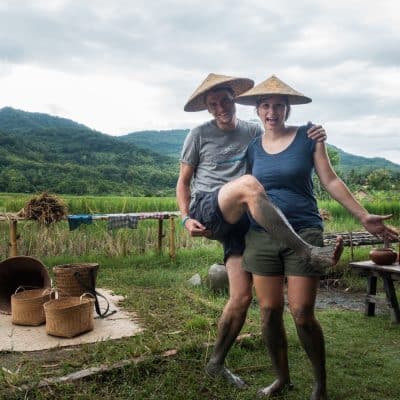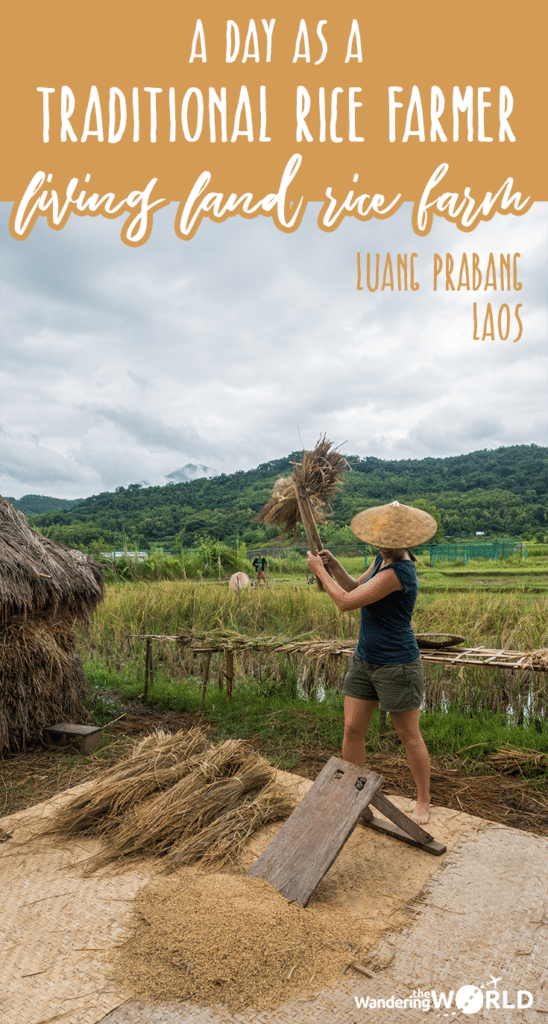On a hot Sunday morning we flew into Luang Prabang, Laos, from Bangkok. After a warm welcome at Khoum Xieng Thong Boutique Villa by Mr. Bill, the (young!) owner, we settled into our room. Flipping through the binder of information on Luang Prabang I found in our room, I came across a page on the Living Land Rice Farm. Getting your hands dirty during a traditional rice farming experience on an organic farm just out of town? I was intrigued.
The Living Land Rice Farm in Luang Prabang
The Living Land Rice Farm is an organic farm just outside of the centre of Luang Prabang. They farm rice the traditional way, maintain an organic garden and run a cooking school. All the rice they harvest is for their own consumption, as they eat rice 5 times a day: with every meal and as a snack.
As a community enterprise, the Living Land Rice Farm supports the locals and helps educate children from disadvantaged families. You can volunteer with hem to give English lessons to children at night as well.
Spending a morning as a traditional rice farmer at the Living Land Rice Farm is one of the top things to do in Luang Prabang. An interactive tour of the farm will take you through the 14 steps for turning 1 rice seed in your hand to a portion of sticky rice on your plate. We guarantee it’s good fun, and we really enjoyed getting our hands (and feet) dirty.
Our Day at the Living Land Rice Farm in Luang Prabang
Our day at the Living Land Rice Farm in Luang Prabang started around 8:00 in the morning, when a tuktuk driver picked us up from our guest house. He dropped us off at the farm, handed us an Asian rice hat, and sent us off to Komla, our guide/teacher for the day.
After taking off our shoes, our group of 6 took a seat around a table in the 2-story wooden building at the edge of the rice fields. Komla told us a little about the farm and what was going to happen today. He also asked us who wanted to stay over for lunch. We were the only ones to sign up for the 5-course homemade Lao lunch he offered. We hardly ever say no when it comes to food.
What does a traditional rice farmer do?
Enough talk, it was time to get our hands dirty and start farming rice the traditional way. Komla, a very funny guy, explained us the 14 steps for turning rice seeds into edible sticky rice. From separating the good seeds from the bad ones with salt water, over plowing the field with Rudolph the water buffalo (hui, hui!), to harvesting the grown rice with a sickle, we did it all. Our favourite step was the last one though: eating the rice!
These are the 14 steps of traditional rice farming:
- Separate the good seeds from the bad with salt water. The good ones sink to the bottom, the empty seeds float.
- Sow the seeds by throwing them on the mud to grow into seedlings.
- Plow the field with Rudolf the water buffalo. Hui, hui!
- Plant the seedlings by sticking them in the mud below the water, about a hand away from each other.
- Nurture the rice plants by managing the flow of water through the little canals between the fields.
- Harvest the grown rice with a sickle and make bundles by binding them together with a couple strands of rice.
- Thresh the rice by slamming the bundles of rice against a wooden board, so the stems let go of the grains.
- Remove the empty grains and leaves by forcefully waving a big bamboo fan over the pile of grains. Easier said than done!
- Carry the harvested rice home with either a backpack, “headpack”, or a stick over your shoulder with baskets on each side.
- Hull the rice (take the skin off) with a foot-operated wooden rice pounder, reminding of a huge mortar and pestle.
- Throw the rice up and down, to separate the lighter chaff from the heavier rice. This was one of the most difficult steps for us: a lot of the rice ended up with the chaff. Whoops!
- Soak the rice.
- Cook the rice by steaming it.
- And finally, eat the rice!
In order to be able to show us tourists every step of the rice farming process, the rice fields are cultivated in a rotation system. Every plot is in another stage, so you can experience every step, no matter what time of the year you visit.
While the ladies at the farm cooked the rice, we squeezed our own palm juice. I hadn’t tried it before, but it actually is pretty good if you like sweet. Komla took us on a tour of the organic garden as well, and we tried our hand at bamboo weaving. The things those guys can make are amazing, but I’m unfortunately not that talented (or practiced). My dog looked more like a llama.
Not all of the rice is cooked into sticky rice though. Part of the rice is turned into rice flour by grinding it between 2 millstones instead of soaking and cooking it. It’s then combined with coconut or palm sugar to make all kinds of delicious rice snacks you didn’t know existed. We sampled a bunch of them and even tried the Living Land Rice Farm’s homemade rice wine (also known as happy water). Yum!
The Living Land Rice Farm Lunch
After trying those different rice snacks we were already pretty full. A light lunch would’ve sufficed, but the 5-course homemade Lao lunch at the Living Land Rice Farm was already booked. Our table was set up on the second floor of the wooden building, with a lovely view over the surrounding rice fields.
When they started bringing up the food, we immediately knew we weren’t going to finish it. On the menu (and our table): Mekong River weed, Keng Kai (chicken) soup, fried mixed vegetables with coconut milk, Olam (chicken stew), and a side of organic salad and sticky rice with eggplant dip, finished with a platter of fresh grapes and dragon fruit.
The food was good and a great way to sample a couple of Lao dishes. However, we wouldn’t recommend to book this lunch after your traditional rice farming experience. A light lunch will do after the rice tasting. We’ve had better Mekong River weed as well. Still, it’s a lovely spot and it’s all homemade!
How much does it cost?
The price tag to spend a morning as a traditional rice farmer at the Living Land Rice Farm in Luang Prabang is 345,000 kip (~$42) per person. This includes the pickup from your ho(s)tel, the hands-on tour, unlimited drinking water, and a rice tasting session. We booked this rice farming experience through Mr. Bill, the friendly owner of our guest house. However, it’s possible to book through the Living Land website as well.
At the start of our day at the Living Land Rice Farm we were offered to stay over for a 5-course homemade Lao lunch after the farming work was done. We agreed, paying another 80,000 kip (~$10) per person.
What should you bring?
You’ll be spending the day at the Living Land Rice Farm on your bare feet, so it doesn’t matter what kind of shoes you’re wearing. Do think about what clothes to wear, as you might end up taking a mud bath if you can’t keep up with Rudolph.
No seriously, you’ll be walking through mud, so maybe don’t wear long pants or your prettiest clothes. Headgear isn’t necessary either, because the tuktuk driver will hand you an Asian (bamboo) rice hat. You’ll definitely want to bring your camera though, and rub yourself with sunscreen and mosquito spray.
We really enjoyed our crash course on traditional rice farming. It also makes you think about the people that have to do this day in day out, probably making barely enough money to feed their families. However, the Living Land Rice Farm tries to make a difference, so you know your money is going to a good cause. We’re very proud to have a certificate saying “I planted rice in Luang Prabang”!
A day at the Living Land Rice Farm in short
What? 4 hour traditional rice farming experience
Where? Luang Prabang, Laos
How much? 345,000 kip per person
Bring? Camera
More info? Living Land website
Like it? Pin it!
Did you find this post helpful? Help us spread the word by sharing this post or pinning the following image.






















Wat een mooi verhaal!